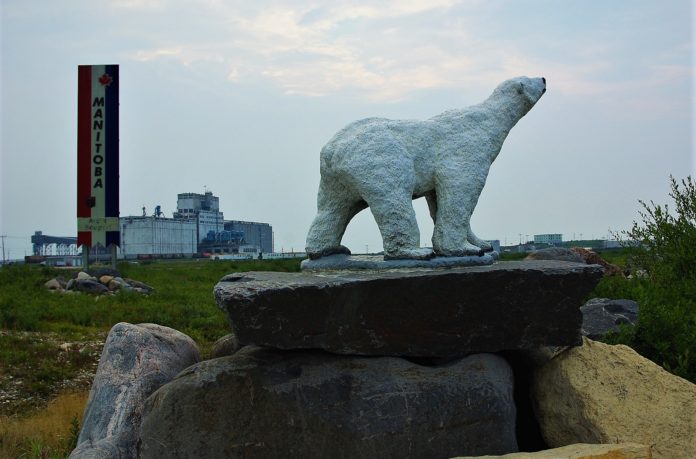So you’ve probably heard about the polar bears… but what else is up there in Churchill? You just might be pleasantly surprised.
Situated north of Manitoba’s timber-line, Churchill has reinvented itself many times over. From fur trade-era forts and continental seaport, to military base and rocket scientists, today, the town’s main industry is tourism – and rightfully so.
If you’ve been wanting to visit Churchill, and thinking about driving there, think again. The paved highway ends in Thompson, and continuing gravel road ends just passed Gillam – still leaving about 300 km short. That means there are three ways to get to this remote northern locale: by plane, by train, or, for the most adventurous, by watercraft.
So why go through all the fuss to get there? Because there are really cool things in Churchill that you won’t see anywhere else. Starting with its most famous residents.
Bears and belugas the prime attractions
The world’s largest known denning area is within Wapusk National Park – named after the Cree word for ‘white bear’ – a vast and remote area spanning almost 11,500 square km from Churchill southeast to York Factory. After hibernating here in summer, the bears congregate near shore to return to the ice-flow. This means hundreds of them pass close by, and often through, the town famously known as the “polar bear capital of the world.”
But the bears aren’t the only creatures attracting tourists. Also known for the presence of beluga whales, July and August are typically the best months to witness these amazing marine mammals, when thousands migrate here to spend time in warm waters that flow into Hudson Bay from the Churchill River. Much like humans like to vacation in warmer climates, apparently so do belugas.
Flora and fauna like nowhere else
Land-lovers can also find lots to covet in Churchill. It’s one of the few places in the world one can go to study the arctic on extended learning vacations, or short day-trip tours. The tundra soil here comes alive each spring with an impressive array of flora, boasting more than 400 native species of wildflowers, shrubs, and other plants.
Outside the town-site, the landscape slowly changes to boreal forests teeming with lemming, hares, caribou, arctic fox, and other wildlife. Bird-watching enthusiasts can’t go wrong either, with 200 species of birds coming to congregate at Akudlik Marsh, nesting ground to many flocks of feathered friends including rare ones like Little Gull and Rock Wren, and northern species like arctic tern, plovers, ptarmigans and snow geese.
For the fishing aficionado, Goose Creek is located 10 km inland down the Churchill River. Accessible by road, the tributary offers arctic grayling, northern pike, and sea run trout. It’s also a great spot for waterfowl hunting come fall.
Churchill’s rugged and remote coastline is heaped with smooth sand stones, granite rocks, and wind-swept boulders. Archaeology in the area shows evidence of humans residing as far back as 4000 years, when the Dené and Cree Indigenous Peoples populated the region. The landscape is desolate and magnificent, and the perfect backdrop for cultural exploration, historic tales, and a fort named after the Prince of Wales.
Fur-trade fort fun to explore
Located across the Churchill River, on the most northerly point possible, is one of Manitoba’s National Historic Sites. Prince of Wales Fort was built by the Hudson Bay Company between 1731 and 1771, to protect England’s interest in the fur-trade during troubled times with France.
The crowning jewel of the construction had to be the outer walls, measuring almost 7 meters high and 11 meters thick. Adorned with more than 40 cannons strategically placed to cover every approach, ironically, the British fort was lost to French warships in 1782 without a single cannon shot fired.
Northern lights glowing in the night
Once you’ve discovered what’s on the ground and in the water, look up. Waaaay up. Did you know the highest intensity of northern lights in the Arctic occurs over Churchill from January to March? That’s the best time of year to see nature’s most dazzling display light up winter’s long dark nights. The best part is, you don’t even have to stand outside in deep-freeze weather to witness their wonder.
The Aurora Domes offer viewing with all the comforts of the great indoors. Visitors get to sit in heated plexi-glass ‘bubbles’ that provide clear observation of the entire night sky, and wait patiently for the brilliantly coloured dancing bands to come out and play. There’s a very good chance you’ll see them, too, because when it’s clear and cold, they almost always appear here.
The domes were originally constructed for scientists to observe the aurora borealis when the Churchill Research Range was operational. After the Canadian government quit using them in the mid 1980’s, they were purchased privately and transformed into a unique and successful tourist attraction. Once again, a new use was found for something that had run its course, in a little town with a long tradition of having to reinvent itself.
Tribute to Inuit Peoples
A trip to Churchill would not be complete without a stop at the Itsanitaq Museum, which offers a precious glimpse at some of the oldest and finest Inuit carvings and artifacts in the world. The quaint museum is open year-round, and pays tribute to the creativity and resourcefulness of Inuit Peoples.
Exhibits on display include a seal-skin kayak, a walrus, and a polar bear. The gift shop has a selection of books about the north, history and outdoor adventure, unique arts and crafts, local preserves and treats, and plenty of other one-of-kind finds.
The kinds of things you’ll only discover in a place that truly is one-of-a-kind.







